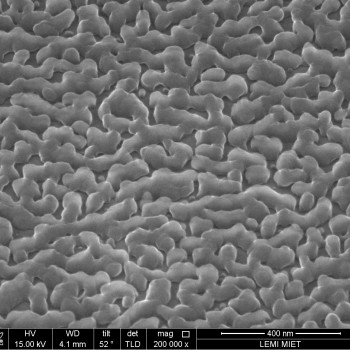
Test sample TSD01 is intended for:
TSD01 consists of large variety of densely packed particles with average diameter around 60 nm. Particles’ shape is not ideally round. Some of them are rather cylindrical, some ones have got vertical walls and sharp corners (like as on the REM photo). These features are necessary to collect enough statistics for further “blind” tip estimation using Deconvolution algorithm.
Qualitative tip’s shape estimation with TSD01
Qualitative tip’s shape estimation could be done by comparison of AFM images of TSD01 surface of different AFM probes. Below you may find AFM images of TSD01, performed by two cantilevers of the same model.
Looking at images’ scales, the one may notice that particles’ height on the left image is more than on the right one. That means that tip #1 penetrates deeper into gaps between particles during the scan. And the tip #1 is just the sharpest one between them both.
Quantitative tip's shape estimation: “Blind” reconstruction of AFM tip’s shape using Deconvolution algorithm
Deconvolution algorithm for AFM surface reconstruction was suggested by J.S. Villarrubia in 1997 and now it is implemented in many different AFM-image-processing programs. It also includes the part, that allows so-called "blind" tip's estimation, when analysing a scan of specific surface program draws tip's profile.
For better understanding of this method let’s imagine an ideal vertical bulk (on the image below) which width is equal to “0”. It’s not difficult to calculate that when a probe passes such an object, its image on AFM topography scan will be just the inverted probe’s shape (a dotted line).

Thus, every particle of topography imaged, which size is comparable to a tip, should hold some information about its real shape. The algorithm of “blind reconstruction” compares shapes of all particles (local maximums) of the topography scan and finds common features between them. On the basis of such comparison it outputs approximated tip’s shape. Reliability of the result depends on particles amount (it should be enough to collect statistics) and their shape (then closer to an “ideal bulk” – than better, as we have seen previously).
Knowing details of "blind" tip's estimation algorithm we could formulate the next criteria to the test sample that could be used for its realization:
Quantitative tip’s shape estimation with TSD01
TSD01 manufacture process determines its physical properties: all particles are being grown chaotically around small, several nanometers, cores. Thus, they have got similar, but very irregular shapes. Some of them may have got sections, close to cylindrical, some of them look to be rounder. They have got many sharp corners too. Writing several dozens of such particles during the same AFM image a tip leaves much information about its true shape from each side. And usually this statistic is enough to get reasonable tip’s images after tip’s “blind” estimation by standard deconvolution procedure.
Below you may find the results of “blind” tip’s shape reconstruction from the AFM scans of TSD01 test structure, which were posted previously:
As the one may notice, the results of tip’s shape estimation correspond to our previously-made suggestion that the probe #1 is sharper than the probe #2.